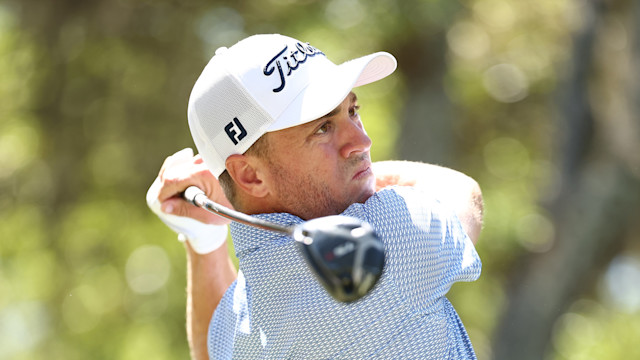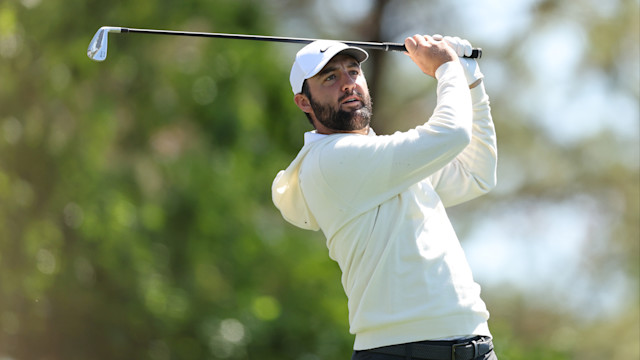quick coaching
5 Tips to Hit More Fairways, Inspired by Keith Mitchell
By Brendon Elliott, PGA
Published on

There's something magical about watching a pro like Keith Mitchell stripe a drive down the middle of the fairway. At the Truist Championship, Mitchell finds himself in the lead through 36 holes. With that trademark silky-smooth swing, it’s hard not to marvel at his consistency off the tee.
Currently ranked 6th in Strokes Gained Off the Tee this season, he's been a model of repeatability, finishing 7th in 2024, 7th in 2022-23, 4th in 2021-22, and 11th in 2020-21. Those aren't just numbers—they're proof of a repeatable, reliable approach to driving that we can all learn from.
So, what makes Mitchell so special with the big stick, and how can you incorporate elements of his approach into your game? Let's break it down.
The Power of the Repeatable Fade
If you've studied Mitchell's game, you know he's committed to a fade. It's not the sexiest shot in golf—that honor probably goes to the high draw that seems to hang in the air forever—but it might be the most reliable.
I've found that most amateur golfers fight a slice, but they're actually fighting the wrong battle. Instead of trying to eliminate side spin completely, I often tell my students to learn to control it like Mitchell does.

Mitchell's fade is intentional and repeatable. He sets up for it, expects it, and most importantly, he accepts it. The fade naturally reduces distance compared to a draw, but the control it offers more than makes up for those few lost yards.
For the average golfer, try this: Aim slightly left of your target (for right-handers; vice versa for lefties), strengthen your grip slightly to prevent an over-fade, and focus on swinging along your body line rather than trying to manipulate the clubface. Accept that the ball will move gently from left to right, and suddenly those trees on the right side of the fairway become a lot less threatening.
Low-Spin Drives for Maximum Distance
One of Mitchell's secrets is his ability to hit low-spin drives that maximize roll-out. With his Mizuno ST-Z 230 driver, he's found equipment that complements his natural swing tendencies.
Equipment matters, but understanding your spin profile matters more. Mitchell knows exactly how much spin he generates and has found a driver that optimizes his launch conditions.
For weekend warriors: consider getting a basic launch monitor session (many golf retailers offer this for free). Understanding your spin rates can be eye-opening. If you're generating too much spin (over 3,000 RPM), you're losing distance. Try a lower-lofted driver or one with a forward center of gravity to reduce spin. Conversely, if your drives fall out of the sky with too little spin, more loft might be your friend.
Body Turn: The Engine of Power
Watch Mitchell's swing closely; you'll notice his tremendous body turn during the backswing. This isn't just for show, it's the engine that generates his power while maintaining control.
The biggest mistake I see with amateur drivers is all-arms swings. Your arms are just along for the ride. The power comes from your body.

Try this: At address, place a club across your shoulders. Make your backswing, focusing on turning your shoulders until the club points at or even slightly beyond your target. If you can make this turn while keeping your lower body relatively stable, you've found the secret to loading power like Mitchell does.
Strategic Course Management
Even with his prodigious driving ability, Mitchell doesn't hit the driver on every par-4 or par-5. His course management is calculated and precise.
The best driver of the ball isn't the one who hits it the farthest—it's the one who knows when not to hit the driver at all.
Try this: Take a page from Mitchell's playbook and think strategically. On holes where trouble lurks at your driver distance, consider a 3-wood or long iron. The goal isn't to hit the driver well; it's to play the hole well. Sometimes that means leaving the big dog in the bag.
The Mitchell-Inspired Alignment Drill
Here's a step-by-step practice drill inspired by Mitchell's approach:
- Place two alignment sticks on the ground. The first should be parallel to your target line, about a foot outside the ball. The second should be at a slight angle, pointing to the left of the target (for right-handers), creating a gradually widening channel.
- Set up with your feet parallel to the first stick, but aim your clubface slightly right of your target.
- Make your normal swing, focusing on turning your shoulders fully in the backswing.
- Try to start the ball just inside the angled stick, allowing it to fade gently toward your target.
- This drill reinforces proper alignment for a fade while giving you immediate feedback on your start line and curve.
The beauty of Mitchell's driving approach isn't just its effectiveness, it's its simplicity. By focusing on a repeatable shape, optimizing equipment for his swing, using his body efficiently, and making smart decisions, he's become one of the tour's most reliable drivers.

And the best part? These aren't skills reserved for tour pros. With focused practice and the right approach, you too can experience the confidence that comes from standing on the tee knowing exactly where your drive is headed.
Now that's a feeling worth working for.
PGA of America Golf Professional Brendon Elliott is an award-winning coach and golf writer. Check out his weekly Monday column on RG.org, and to learn more about Brendon, visit OneMoreRollGolf.com.



